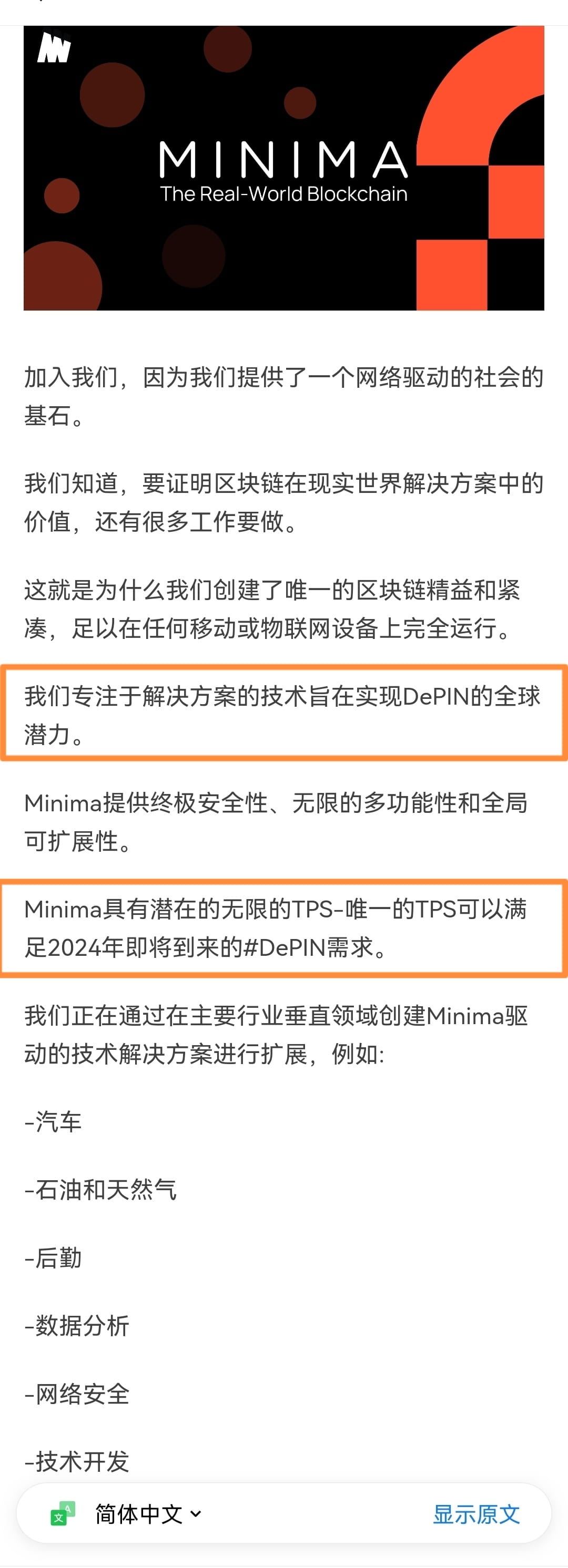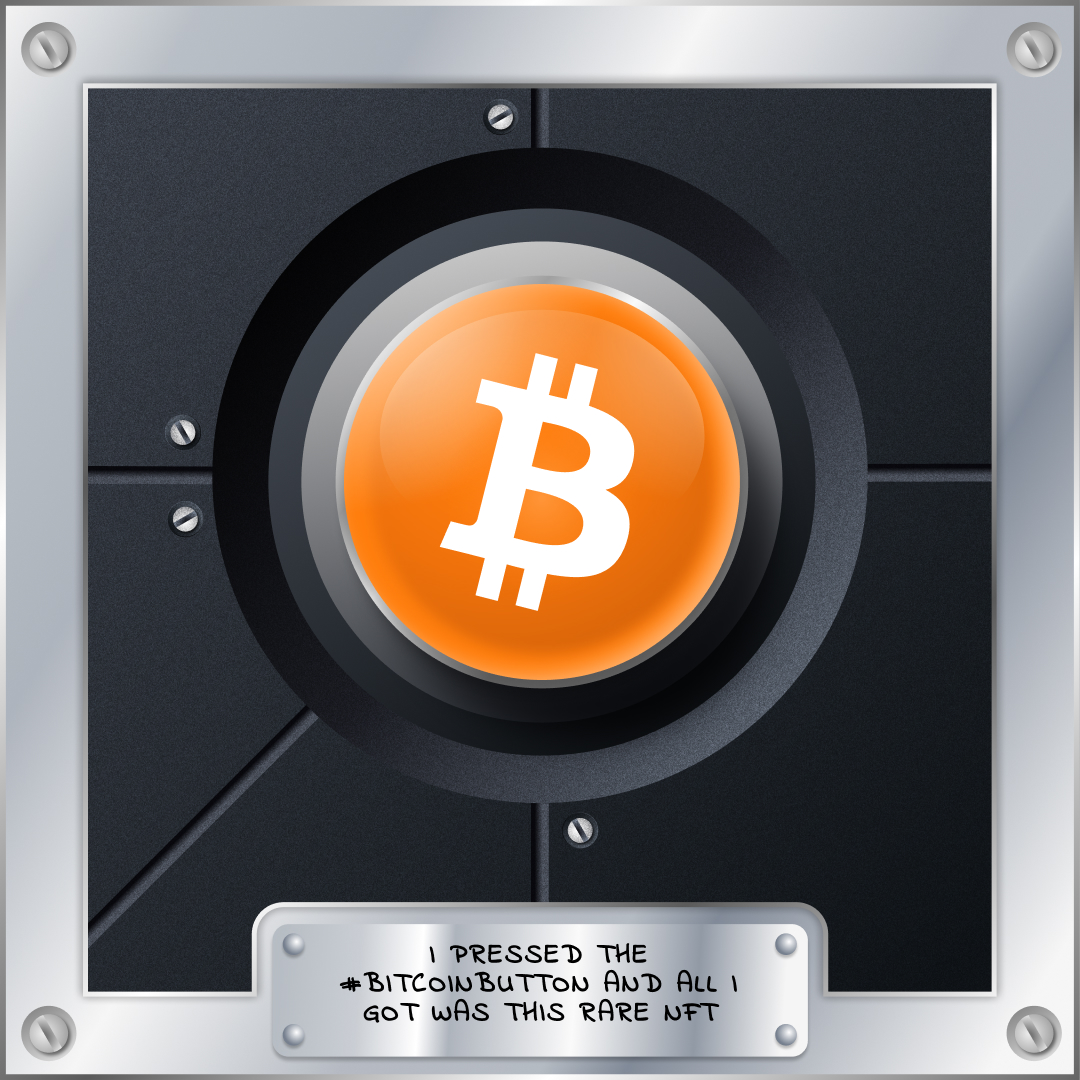MINIMA万物互联
@Square-Creator-6e21245d7dcf
Minima是去中心化超精益区块,小到可以在手机上运行节点。
Following
Followers
Liked
Shared
See original
PINNED
💹Minima’s 2024 Depin track trip
1)🔗(DePINs) Decentralized Physical Infrastructure Network – a word you often hear and read – 🔗
We break it down now in this thread 🧵
2) What are depins? They are decentralized, community-owned infrastructure systems based on blockchain technology. From e-bike sharing to storage solutions, they provide alternatives to centralized platforms like Uber, providing tokens to contributors.
3) There are two types of depin: physical resource network (PRN) is location-dependent and provides irreplaceable services, while digital resource network (DRN) provides replaceable resources that are not location-dependent.
4) How do depins work? They connect physical assets to the blockchain through providers, middleware, and public ledgers. Providers provide the hardware, users pay with tokens, and rewards are distributed based on middleware.
5) The DePIN industry covers computing market, wireless coverage, data wholesale, service market, energy services and vertical advertising network.
6) Four key players make depin work: hardware (prn and drn), hardware operators (providers), tokens and users. This is a community effort.
7) depin uses the “flywheel effect” of tokens to drive network growth. A weighted selection algorithm increases token value, attracting more providers and investors as the network expands.
8) The benefits of depin include incentives, scalability, permissionless access, cost-effectiveness, censorship resistance, and integration with DeFi, revolutionizing the infrastructure model.
9) DePINs also face challenges: incentive model, competition with centralized giants such as Amazon, technical complexity, profitability, and lack of proven success stories. Despite the challenges, depin has significant potential to drive real-world demand by entering and expanding into mature markets.
If wallets are the entry point to crypto, then a decentralized network of physical infrastructure (Depin) is its foundation! 💻🌐
Depin is more than just an opportunity for organizations running in Web3. All organizations and individuals can benefit from a higher level of data and product control through decentralized infrastructure. 🌐💻
1)🔗(DePINs) Decentralized Physical Infrastructure Network – a word you often hear and read – 🔗
We break it down now in this thread 🧵
2) What are depins? They are decentralized, community-owned infrastructure systems based on blockchain technology. From e-bike sharing to storage solutions, they provide alternatives to centralized platforms like Uber, providing tokens to contributors.
3) There are two types of depin: physical resource network (PRN) is location-dependent and provides irreplaceable services, while digital resource network (DRN) provides replaceable resources that are not location-dependent.
4) How do depins work? They connect physical assets to the blockchain through providers, middleware, and public ledgers. Providers provide the hardware, users pay with tokens, and rewards are distributed based on middleware.
5) The DePIN industry covers computing market, wireless coverage, data wholesale, service market, energy services and vertical advertising network.
6) Four key players make depin work: hardware (prn and drn), hardware operators (providers), tokens and users. This is a community effort.
7) depin uses the “flywheel effect” of tokens to drive network growth. A weighted selection algorithm increases token value, attracting more providers and investors as the network expands.
8) The benefits of depin include incentives, scalability, permissionless access, cost-effectiveness, censorship resistance, and integration with DeFi, revolutionizing the infrastructure model.
9) DePINs also face challenges: incentive model, competition with centralized giants such as Amazon, technical complexity, profitability, and lack of proven success stories. Despite the challenges, depin has significant potential to drive real-world demand by entering and expanding into mature markets.
If wallets are the entry point to crypto, then a decentralized network of physical infrastructure (Depin) is its foundation! 💻🌐
Depin is more than just an opportunity for organizations running in Web3. All organizations and individuals can benefit from a higher level of data and product control through decentralized infrastructure. 🌐💻
See original
Minima Partners with OPP (Online Payments Platform) to Commoditize Private Charging Points Globally with $7.3 Billion EV Token.
A first-layer blockchain focused on Decentralized Physical Infrastructure Network (DePIN) solutions, has partnered with Online Payments Platform (OPP), a leading global payment services provider, to transform the Electric Vehicle (EV) charging industry. The partnership aims to combine OPP’s comprehensive payment solutions with Minima’s fully decentralized and device-agnostic blockchain network, allowing EV drivers to rent out their private chargers to other members of the public. According to a recent report
Shell stated that “49% of people have not yet adopted an electric vehicle because they would like to see better charging point availability.” This solution from Minima aims to change this by decentralizing the management of EV charging services. Unlike the current centralized model that relies on specific service providers for access and payment management, this approach enables direct peer-to-peer interactions through the tokenization of energy.
Charging Point Operators (CPOs) and private wallbox owners will be able to accept tokens generated on the Minima blockchain. Tokens will represent kWh balances, access rights, or authentication details. This will enable a safer and more efficient ecosystem for EV charging, providing a new way to manage energy resources and facilitating access to a broad network.
A first-layer blockchain focused on Decentralized Physical Infrastructure Network (DePIN) solutions, has partnered with Online Payments Platform (OPP), a leading global payment services provider, to transform the Electric Vehicle (EV) charging industry. The partnership aims to combine OPP’s comprehensive payment solutions with Minima’s fully decentralized and device-agnostic blockchain network, allowing EV drivers to rent out their private chargers to other members of the public. According to a recent report
Shell stated that “49% of people have not yet adopted an electric vehicle because they would like to see better charging point availability.” This solution from Minima aims to change this by decentralizing the management of EV charging services. Unlike the current centralized model that relies on specific service providers for access and payment management, this approach enables direct peer-to-peer interactions through the tokenization of energy.
Charging Point Operators (CPOs) and private wallbox owners will be able to accept tokens generated on the Minima blockchain. Tokens will represent kWh balances, access rights, or authentication details. This will enable a safer and more efficient ecosystem for EV charging, providing a new way to manage energy resources and facilitating access to a broad network.
See original
Minima partners with ABB Innovation Center Synner Leap to drive innovation in the energy and industrial IoT sectors.
The innovation arm of ABB, a global technology leader with $$ 320+ billion in revenue across electrification, robotics, automation and motion control, is known for pioneering advanced engineering solutions that improve industrial productivity and energy efficiency. This collaboration marks an important step forward in exploring and leveraging the power of blockchain in groundbreaking applications in energy management and industrial IoT solutions, as well as potential applications in different industries. horizontal wire,
Supported by Sandvik, Hitachi Energy, Epilock, Microsoft Corporation, Pyramid Analysis, PEDAB, Level 21 Management AB, International Business Machines Corporation, among others. Thanks for reading Minimalism! Subscribe to receive new posts for free and support my work. Subscribe Through this partnership, Minima will leverage its unique blockchain capabilities, including the ability to run a full node on any device, to bring unparalleled security, efficiency and scalability to the energy and industrial sectors. Integration with ABB and its vast partner ecosystem opens new doors to innovative solutions, laying the foundation for a smarter, more sustainable future.
The innovation arm of ABB, a global technology leader with $$ 320+ billion in revenue across electrification, robotics, automation and motion control, is known for pioneering advanced engineering solutions that improve industrial productivity and energy efficiency. This collaboration marks an important step forward in exploring and leveraging the power of blockchain in groundbreaking applications in energy management and industrial IoT solutions, as well as potential applications in different industries. horizontal wire,
Supported by Sandvik, Hitachi Energy, Epilock, Microsoft Corporation, Pyramid Analysis, PEDAB, Level 21 Management AB, International Business Machines Corporation, among others. Thanks for reading Minimalism! Subscribe to receive new posts for free and support my work. Subscribe Through this partnership, Minima will leverage its unique blockchain capabilities, including the ability to run a full node on any device, to bring unparalleled security, efficiency and scalability to the energy and industrial sectors. Integration with ABB and its vast partner ecosystem opens new doors to innovative solutions, laying the foundation for a smarter, more sustainable future.
See original
Embracing Parallelism: Revealing Minima’s Scalability through Technological Innovation
Imagine that Block Processing is represented by a truck carrying apples, driving down a road
Apples represent transactions on your blockchain, and for every apple you transport on the road - 1 transaction is processed.
Now let us assume that this truck can load 1000 apples and it takes 1 hour to travel down the road.
So - in this example - you can process 1000 transactions per hour.
very simple
Now let's say you want to increase this or do it faster. what can you do
You can make the truck bigger. This way you can put more apples in it and handle more things. This can be thought of as an increase in block size
You can make the truck go faster. This way you can go faster down the road and process more transactions. This can be considered an increase in CPU speed.
Neither solution is very good...
There is a limit to how big a truck can be safely on the road. Having huge blocks means that most users can't keep up and are kicked off the network.
There is a limit to the speed of a truck. You can't just double the speed of a truck whenever you want. It's impossible for a computer to simply double the raw power when you need it
Therefore, even when used together, this scaling is subject to real-world limitations.
But there is a third way. A very simple, scalable, and secure way.
Multipurpose truck.
They can be normal size, they can travel at normal speeds.
They run in parallel. That's the trick. You can have 10 trucks on the road simultaneously and increase transaction throughput 10x.
No need for special large super-fast trucks. Very good!
…
This is called parallel processing and is a very old and well understood part of computer science. Most computers and especially phones already have multiple CPU cores - but importantly - your program needs to work in such a way to be compatible with parallel architectures
This is how minima is designed. Minima processes block transactions in parallel. This way, even low-end devices can keep up with high transaction throughput.
Parallel Transaction Processing: Efficiency in Action
Minima uses a UTXO model, which means transactions in blocks are processed in parallel, as opposed to the non-force-driven sequential approach seen on ETH.
Imagine that Block Processing is represented by a truck carrying apples, driving down a road
Apples represent transactions on your blockchain, and for every apple you transport on the road - 1 transaction is processed.
Now let us assume that this truck can load 1000 apples and it takes 1 hour to travel down the road.
So - in this example - you can process 1000 transactions per hour.
very simple
Now let's say you want to increase this or do it faster. what can you do
You can make the truck bigger. This way you can put more apples in it and handle more things. This can be thought of as an increase in block size
You can make the truck go faster. This way you can go faster down the road and process more transactions. This can be considered an increase in CPU speed.
Neither solution is very good...
There is a limit to how big a truck can be safely on the road. Having huge blocks means that most users can't keep up and are kicked off the network.
There is a limit to the speed of a truck. You can't just double the speed of a truck whenever you want. It's impossible for a computer to simply double the raw power when you need it
Therefore, even when used together, this scaling is subject to real-world limitations.
But there is a third way. A very simple, scalable, and secure way.
Multipurpose truck.
They can be normal size, they can travel at normal speeds.
They run in parallel. That's the trick. You can have 10 trucks on the road simultaneously and increase transaction throughput 10x.
No need for special large super-fast trucks. Very good!
…
This is called parallel processing and is a very old and well understood part of computer science. Most computers and especially phones already have multiple CPU cores - but importantly - your program needs to work in such a way to be compatible with parallel architectures
This is how minima is designed. Minima processes block transactions in parallel. This way, even low-end devices can keep up with high transaction throughput.
Parallel Transaction Processing: Efficiency in Action
Minima uses a UTXO model, which means transactions in blocks are processed in parallel, as opposed to the non-force-driven sequential approach seen on ETH.
See original
Minima partners with Streamr to create secure live streaming
Minima's cutting-edge blockchain is the only L1 so streamlined and compact that each device can run a full build and verification node, providing unparalleled data authentication and verification capabilities. It can run on mobile phones, IoT devices, main units in cars, and eventually directly on chips.
Not only does this make Minima the only fully decentralized layer 1 in the world, but it also provides a ton of power and functionality to devices running Enterprise and DePIN space nodes. When combined with Streamr's innovative data streaming technology, this partnership will enable a highly secure and resilient platform for sending and receiving data in real time.
This collaboration aims to decentralize the infrastructure required for data connectivity, making data more accessible, affordable, and secure for everyone. By taking full advantage of Minima and Streamr, users will benefit from seamless integration of authentication data streams, opening new possibilities for applications and industrial use cases.
A vision for the future of data
Minima CEO Hugo Feiler said: "Working with Streamr to launch 1.0 mainnet is not only a milestone for our two companies, but also an important step in data decentralization." Streamr is committed to enabling real-time data streaming without a central authority , which is fully consistent with our mission to provide secure, decentralized access to data on any device. Together we are laying the foundation for a future of data sovereignty and privacy. ”Streamr’s powerful data broadcast network enables decentralized and secure real-time data streaming, ensuring that users have real-time access to information without sacrificing security or privacy. This collaboration with Minima strengthens Streamr’s commitment to building a new data economy for users You have control over your data, and barriers to data access are removed.
Minima's cutting-edge blockchain is the only L1 so streamlined and compact that each device can run a full build and verification node, providing unparalleled data authentication and verification capabilities. It can run on mobile phones, IoT devices, main units in cars, and eventually directly on chips.
Not only does this make Minima the only fully decentralized layer 1 in the world, but it also provides a ton of power and functionality to devices running Enterprise and DePIN space nodes. When combined with Streamr's innovative data streaming technology, this partnership will enable a highly secure and resilient platform for sending and receiving data in real time.
This collaboration aims to decentralize the infrastructure required for data connectivity, making data more accessible, affordable, and secure for everyone. By taking full advantage of Minima and Streamr, users will benefit from seamless integration of authentication data streams, opening new possibilities for applications and industrial use cases.
A vision for the future of data
Minima CEO Hugo Feiler said: "Working with Streamr to launch 1.0 mainnet is not only a milestone for our two companies, but also an important step in data decentralization." Streamr is committed to enabling real-time data streaming without a central authority , which is fully consistent with our mission to provide secure, decentralized access to data on any device. Together we are laying the foundation for a future of data sovereignty and privacy. ”Streamr’s powerful data broadcast network enables decentralized and secure real-time data streaming, ensuring that users have real-time access to information without sacrificing security or privacy. This collaboration with Minima strengthens Streamr’s commitment to building a new data economy for users You have control over your data, and barriers to data access are removed.
See original
MINIMA
Proof of concept using successful tests
mobilityXlab
Secure real-time V2V messaging without intermediaries
Sensitive information transfer with end-to-end security
Provide access control and V2X service authentication via NFT
Securely exchange vehicle location and dynamic data
Automatic payments directly from the vehicle
Electric vehicle online and offline charging payments
Create branded fungible tokens for value transfer
Real-time secure sharing of traffic information between vehicles
Proof of concept using successful tests
mobilityXlab
Secure real-time V2V messaging without intermediaries
Sensitive information transfer with end-to-end security
Provide access control and V2X service authentication via NFT
Securely exchange vehicle location and dynamic data
Automatic payments directly from the vehicle
Electric vehicle online and offline charging payments
Create branded fungible tokens for value transfer
Real-time secure sharing of traffic information between vehicles















